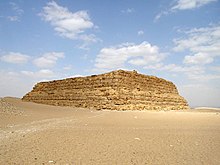Mastaba
Mastaba ( Arabic مصطبة, DMG maṣṭaba 'stone bench') is a type of tomb of ancient Egyptian culture named after the Egyptian-Arabic word for bank . Geometrically , the building is a truncated pyramid with a rectangular floor plan, a relatively low height and sloping side walls. In terms of art history, mastabas can be assigned to a line of development that begins with the elite graves of the Thinite period , leads to the construction of the pyramid tombs in the royal area and ends in the private area at the end of the 12th dynasty. Stages of this development can be shown with examples from Abydos , Saqqara and Gizeh , but also in other places.
Building history
Mastabas were built from the unification of the empire until the end of the Middle Kingdom . The pyramids replaced the mastaba in the 3rd dynasty with a few exceptions as a royal tomb, while the mastaba continued to exist as a private tomb.
Mastabas of the early Dynastic period

The mastabas of the unification period are decorated with a niche arrangement, which represents a kind of royal palace or gods fortress . Monumental examples of this type were found mainly in Saqqara . The burial took place in a pit below the actual building. The pits have been accessible via lockable stairs since the middle of the 1st dynasty . In comparison, the mastabas of the lower courtiers are usually rather simple and do not have a niche facade.
At the end of the dynasty, the niche facade (presumably for static purposes) disappears. The building now mostly has a smooth exterior and two open cult sites in the east of the building. The underground tombs are often carved into the rock and form something like a house grave.
Mastabas of the old kingdom

In the 3rd and especially 4th dynasties, the places of worship were decorated more and more elaborately with reliefs or paintings, while the underground tombs, which are now mostly reached through a shaft, are kept very simple.
At the end of the Old Kingdom, the classic mastaba shape dissolves. The decoration is now mostly reduced to a false door , while the burial chamber is decorated more and more often. Most mastabas of the 1st Intermediate Period follow this type.
Mastabas of the Middle Kingdom
In the 12th Dynasty, the mastaba experienced a rebirth at the royal cemeteries ( el-Lisht , Dahshur ) when the court moved north again to the vicinity of the old residential cemeteries , whereby two types can now be distinguished. There are mastabas with decorated interiors and those that have no interiors and are decorated and labeled on the outside. In the Middle Kingdom, the grave shaft leads into the depths next to the mastababau, while in the Old Kingdom it was mostly driven underground from the building. After the 12th Dynasty, mastabas were replaced by other grave types.
See also
- List of Egyptian pyramids
- Funeral rite
- The Mastaba - Project for the United Arab Emirates by Christo and Jeanne-Claude
literature
- Dieter Arnold : Lexicon of Egyptian architecture. Artemis & Winkler, Zurich 1997, ISBN 3-7608-1099-3 .
- Hans Bonnet : Mastaba. In: Lexicon of Egyptian Religious History. Nikol, Hamburg 2000, ISBN 3-937872-08-6 , pp. 442-444.
- Ulrike Fritz: Typology of the mastaba's graves of the Old Kingdom. Structural analysis of an ancient Egyptian grave type. Achet, Berlin 2004, ISBN 3-933684-19-6 , (Achet - Writings on Egyptology, A 5).
- Wolfgang Helck , Eberhard Otto : grave. In: Small Lexicon of Egyptology. Harrassowitz, Wiesbaden 1999, ISBN 3-447-04027-0 , pp. 107-110.
- Hans Kayser : The Mastaba of Uhemka - A grave in the desert. Torchbearers, Hanover 1964.
- Peter Der Manuelian : Memphite private tombs of the Old Kingdom. In: Kathryn A. Bard (Ed.): Encyclopedia of the Archeology of Ancient Egypt. Routledge, London 1999, ISBN 0-415-18589-0 , pp. 493-97.
- Auguste Mariette ; Gaston Maspero (Ed.): Les Mastabas de l'Ancien Empire. Vieweg, Paris 1898 ( online, digitized by Heidelberg University Library ).
- Margaret Alice Murray: Saqqara Mastabas Part I. British School of Archeology in Egypt, London 1905.
Web links
- The Mastaba des Akhethétep - video with “ambient sound” and spoken text by the French Ministère de la culture et de la communication
- Mastabas the Middle Kingdom (Engl.)
Individual evidence
- ↑ Walter B. Emery: Egypt, History and Culture of the Early Period, 3200-2800 BC. Chr. Wilhelm Goldmann Verlag, Munich 1961, pp. 138–155.
- ↑ Walter B. Emery: Egypt, History and Culture of the Early Period, 3200-2800 BC. Chr.Wilhelm Goldmann Verlag, Munich 1961, p. 155.
- ^ Dieter Arnold: Middle Kingdom Tomb Architecture at Lisht. Egyptian Expedition XXVIII, Metropolitan Museum of Art, New York 2008, ISBN 9781588391940 , pp. 26-30.

